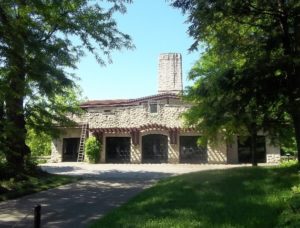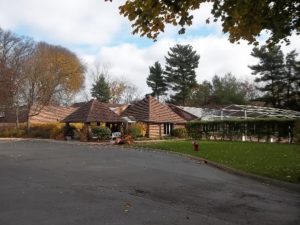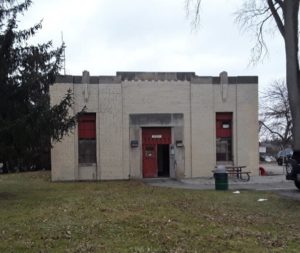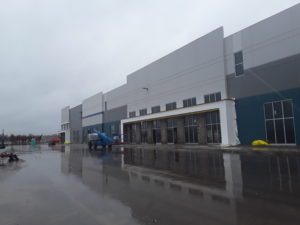Showcasing Ford’s Legacy through Environmental Risk Management
The Ford family and the Ford Motor Company have a rich history throughout southeastern Michigan. PM Environmental (PM) is proud to be able to support this legacy by servicing the environmental needs of various Ford properties.
Henry Ford, industrialist and founder of the Ford Motor Company, chose Dearborn, Michigan as the headquarters for his business, as well as the site of his vast estate, Fair Lane. He turned control of his company over to his son, Edsel Ford, who then passed the business on to his grandson. The company has been in continuous family control for over 100 years.
The Ford Motor Company would go on to become a household name and one of the largest automobile companies in the world. Ford’s presence helped solidify Detroit’s reputation as the “Motor City”. To this day, Ford’s influence remains spread throughout Metro Detroit, from multiple Ford family estates to former plants and industrial buildings. PM has provided environmental services on many projects that showcase Ford’s legacy in Metro Detroit.
Fair Lane Estate
 Located on the west side of Fair Lane Drive, east of the Rouge River in Dearborn, Michigan sits Henry Ford’s vast 1,300-acre estate, Fair Lane. This Henry Ford estate was constructed between 1914 and 1915. Famed architect Frank Lloyd Wright consulted on the initial design, but his assistant, Marion Mahony Griffin, completed the project.
Located on the west side of Fair Lane Drive, east of the Rouge River in Dearborn, Michigan sits Henry Ford’s vast 1,300-acre estate, Fair Lane. This Henry Ford estate was constructed between 1914 and 1915. Famed architect Frank Lloyd Wright consulted on the initial design, but his assistant, Marion Mahony Griffin, completed the project.
The estate contains a manor house, powerhouse, greenhouse, potting shed, two metal pole barns, a small fruit cellar, and a boat house. The property was historically a farm and mill. The Ford family occupied the property until the early 1950s, at which time Ford Motor Company took over the property and utilized it for meetings and trainings for dealership employees. Ford Motor Company gifted the subject property to the University of Michigan Dearborn in 1957. In 1966, a portion of the estate was designated as a National Historic Landmark. Since that time, it has been maintained and utilized for tours and educational activities.
PM completed a Ground Penetrating Radar (GPR) survey, advanced 14 soil borings, installed one temporary monitoring well, sampled two existing monitoring wells, and collected soil and groundwater samples to assess the recognized environmental conditions (RECs) identified in a previous Phase I ESA PM completed for the property. One anomaly consistent with an orphan underground storage tank (UST) was identified during the GPR survey.
The residual sludge in the UST was sampled and determined to be associated with gasoline. The capacity of this tank was estimated to be approximately 300 gallons. In preparation for removal of this UST, a second UST was discovered at the subject property. The capacity of the second tank was estimated to be approximately 1,000 gallons. The former contents of this tank were unknown but were believed to be fuel oil based on its location adjacent to the powerhouse. The USTs were removed and a confirmed released was reported to the Michigan Department of Environment, Great Lakes, and Energy (EGLE).
Edsel and Eleanor Ford House
 Henry’s son, Edsel Ford, chose Grosse Pointe Shores, Michigan, as the site of his estate. Located at 1100 Lake Shore Drive, the 87-acre property sits along the shores of Lake St. Clair. Designed by architect Albert Kahn, construction began in 1926. Edsel and his wife, Eleanor, took up residence there in 1928. The estate contains a mansion, powerhouse, pool house, playhouse, garage, and south cottage.
Henry’s son, Edsel Ford, chose Grosse Pointe Shores, Michigan, as the site of his estate. Located at 1100 Lake Shore Drive, the 87-acre property sits along the shores of Lake St. Clair. Designed by architect Albert Kahn, construction began in 1926. Edsel and his wife, Eleanor, took up residence there in 1928. The estate contains a mansion, powerhouse, pool house, playhouse, garage, and south cottage.
In 1979, the property was listed on the National Register of Historic Places and was designated a National Historic Landmark in 2016. Today, The Edsel & Eleanor Ford House is open to the public for guided tours. It also hosts special events, classes, and lectures.
Several restoration projects have been started in recent years, most of which aim to fix deterioration to the main house. PM was retained by the Edsel and Eleanor Ford House to provide oversight and documentation of the abatement and disposal of regulated asbestos containing materials located in the Ford House Visitor Center. These activities were performed in support of planned demolition activities.
Newburgh Mill
 Henry Ford built many industrial buildings and mills along the Middle Rouge River. The 4,200-square-foot Newburgh Mill located at 37401 Edward N. Hines Drive in Livonia, was built in 1935 when Newburgh Lake was created by construction of a Rouge River dam in 1934. It was one of the last of Ford’s Village Industries properties to be built along the river.
Henry Ford built many industrial buildings and mills along the Middle Rouge River. The 4,200-square-foot Newburgh Mill located at 37401 Edward N. Hines Drive in Livonia, was built in 1935 when Newburgh Lake was created by construction of a Rouge River dam in 1934. It was one of the last of Ford’s Village Industries properties to be built along the river.
The property was developed prior to the 1930s as a cider mill, which was demolished when the current building was constructed. The new building operated as a small micro-factory to manufacture twist drills for the Ford factories, which included a small hydroelectric generator and plant. It was switched to manufacturing small parts for aircraft engines during WWII. The property was deeded to Wayne County in 1948. Today, Newburgh Mill is headquarters for the Wayne County Forestry Division and Sheriff’s Department Mounted Division.
PM performed a Phase I Environmental Site Assessment (ESA) on the property. A few recognized environmental conditions (RECs) were identified related to the past utilization as drill and airplane part manufacturing operations and a hydroelectric power plant. Additionally, there are potential RECs for two former USTs, one 2,000-gallon fuel oil and one 600-gallon gasoline for refueling county vehicles (both removed in 1991). Verification of the presence of contaminants potentially associated with these RECs may be determined through a Phase II ESA investigation.
Significant interior renovations are planned. An asbestos containing materials (ACM) survey will determine if asbestos is present in the building materials that will be disturbed.
Former Ford Wixom Plant
 In Wixom, Michigan, located on Wixom Road and just north of I-96, sat a blighted property characterized by crumbling concrete and debris. The former Ford Motor Company assembly plant site ended industrial operations over ten years ago and then sat vacant. A six-foot tall security fence surrounded much of the 182.53-acre property. After demolition activities in 2013, former concrete building foundations, driveways, and building slab areas sat exposed, as well as several former pit and basement areas.
In Wixom, Michigan, located on Wixom Road and just north of I-96, sat a blighted property characterized by crumbling concrete and debris. The former Ford Motor Company assembly plant site ended industrial operations over ten years ago and then sat vacant. A six-foot tall security fence surrounded much of the 182.53-acre property. After demolition activities in 2013, former concrete building foundations, driveways, and building slab areas sat exposed, as well as several former pit and basement areas.
PM was retained by the developer to perform environmental due diligence, due care activities, and prepare a Brownfield Plan and Act 381 Work Plan.
In March 2019, the Oakland County Brownfield Redevelopment Authority approved Brownfield Tax Credits and a Brownfield Plan for the project. The $150 million project is eligible for up to $24.2 million in reimbursement from tax increment revenues, $12.2 million for Brownfield Tax Increment Financing (TIF) and approximately $12 million in tax credit through the formerly approved Brownfield Michigan Business Tax (MBT).
Redevelopment efforts renovated this property into a new tech and manufacturing park. This logistics hub consists of six buildings on 1.3 million square feet with associated parking, sidewalks, drives, and utilities. Job creation estimates based on the square footage and use range from 500 up to 1,000 jobs. This redevelopment will act as a major catalyst in future reinvestment in the Wixom Road corridor and will assist the city in reaching their Vision 2025 goals.
Publication Details
Date
October 17, 2022



